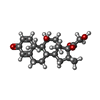+Search query
-Structure paper
| Title | Structures of the glucocorticoid-bound adhesion receptor GPR97-G complex. |
|---|---|
| Journal, issue, pages | Nature, Vol. 589, Issue 7843, Page 620-626, Year 2021 |
| Publish date | Jan 6, 2021 |
 Authors Authors | Yu-Qi Ping / Chunyou Mao / Peng Xiao / Ru-Jia Zhao / Yi Jiang / Zhao Yang / Wen-Tao An / Dan-Dan Shen / Fan Yang / Huibing Zhang / Changxiu Qu / Qingya Shen / Caiping Tian / Zi-Jian Li / Shaolong Li / Guang-Yu Wang / Xiaona Tao / Xin Wen / Ya-Ni Zhong / Jing Yang / Fan Yi / Xiao Yu / H Eric Xu / Yan Zhang / Jin-Peng Sun /  |
| PubMed Abstract | Adhesion G-protein-coupled receptors (GPCRs) are a major family of GPCRs, but limited knowledge of their ligand regulation or structure is available. Here we report that glucocorticoid stress ...Adhesion G-protein-coupled receptors (GPCRs) are a major family of GPCRs, but limited knowledge of their ligand regulation or structure is available. Here we report that glucocorticoid stress hormones activate adhesion G-protein-coupled receptor G3 (ADGRG3; also known as GPR97), a prototypical adhesion GPCR. The cryo-electron microscopy structures of GPR97-G complexes bound to the anti-inflammatory drug beclomethasone or the steroid hormone cortisol revealed that glucocorticoids bind to a pocket within the transmembrane domain. The steroidal core of glucocorticoids is packed against the 'toggle switch' residue W, which senses the binding of a ligand and induces activation of the receptor. Active GPR97 uses a quaternary core and HLY motif to fasten the seven-transmembrane bundle and to mediate G protein coupling. The cytoplasmic side of GPR97 has an open cavity, where all three intracellular loops interact with the G protein, contributing to the high basal activity of GRP97. Palmitoylation at the cytosolic tail of the G protein was found to be essential for efficient engagement with GPR97 but is not observed in other solved GPCR complex structures. Our work provides a structural basis for ligand binding to the seven-transmembrane domain of an adhesion GPCR and subsequent G protein coupling. |
 External links External links |  Nature / Nature /  PubMed:33408414 PubMed:33408414 |
| Methods | EM (single particle) |
| Resolution | 2.9 - 3.1 Å |
| Structure data | EMDB-30602, PDB-7d76: EMDB-30603, PDB-7d77: |
| Chemicals |  ChemComp-PLM:  ChemComp-Y01:  ChemComp-GXR:  ChemComp-CLR:  ChemComp-HCY:  ChemComp-HOH: |
| Source |
|
 Keywords Keywords | MEMBRANE PROTEIN / GPCR / GPR97 / complex / adhesion G protein-coupled receptor |
 Movie
Movie Controller
Controller Structure viewers
Structure viewers About Yorodumi Papers
About Yorodumi Papers







 homo sapiens (human)
homo sapiens (human)